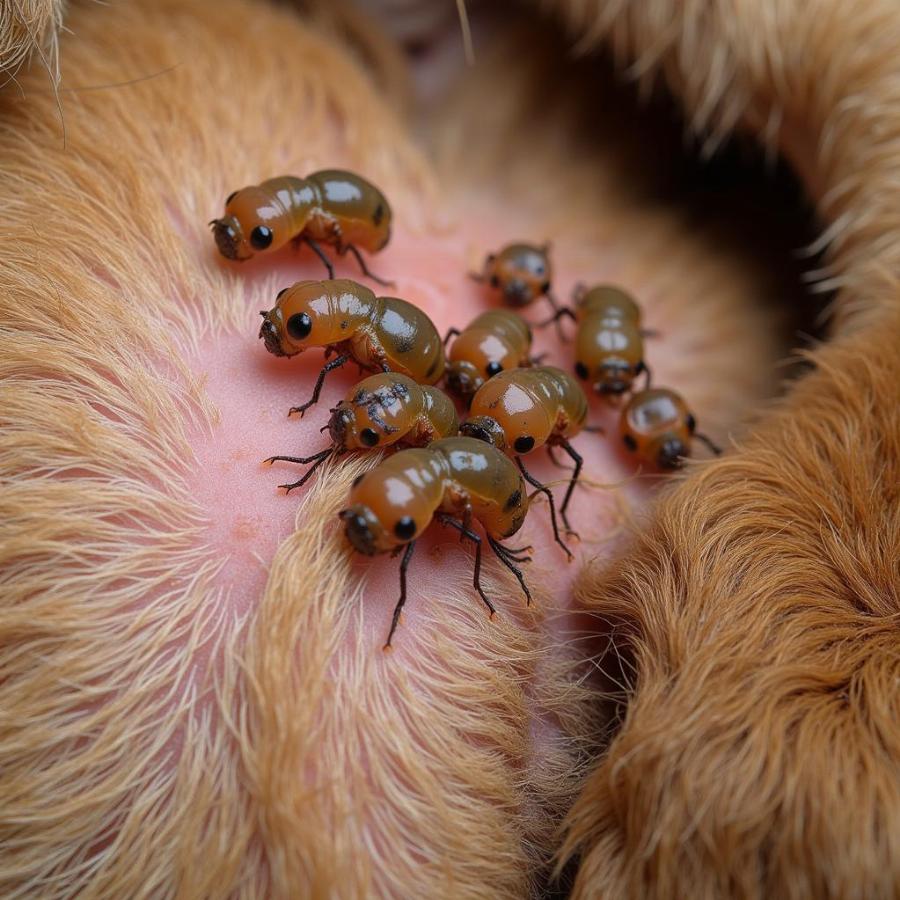Fly strike (myiasis) in dogs is a serious condition where flies lay eggs on a dog’s skin, which then hatch into maggots that feed on the dog’s flesh. This distressing condition can cause significant pain and discomfort for your furry friend and, if left untreated, can lead to serious health complications. Understanding fly strike, its causes, prevention, and treatment is crucial for every responsible dog owner.
Understanding Fly Strike in Dogs
Fly strike occurs when certain species of flies, particularly blowflies, are attracted to a dog’s coat, often due to unsanitary conditions or existing wounds. These flies lay their eggs in damp, soiled areas, or open wounds. The eggs hatch into maggots, which then burrow into the dog’s skin and begin to feed on its tissue. This can quickly lead to a severe infestation, causing immense pain, infection, and even tissue damage. Early detection and prompt treatment are vital to prevent serious complications.
 Hình ảnh chó bị nhiễm giòi
Hình ảnh chó bị nhiễm giòi
Identifying the Signs of Fly Strike
Recognizing the symptoms of fly strike is the first step towards effective treatment. Common signs include a foul odor emanating from the affected area, visible maggots crawling on the skin, restlessness, excessive licking or biting at a particular spot, matted fur, and open sores. If you notice any of these signs, it’s crucial to seek veterinary attention immediately.
What does fly strike look like on a dog?
You might see maggots, which are small, white, worm-like creatures, moving in your dog’s fur or on their skin. The affected area may also be red, swollen, and have a foul smell.
Preventing Fly Strike in Your Dog
Prevention is always better than cure. Maintaining good hygiene is key to preventing fly strike. Regularly groom your dog, especially during warmer months, paying close attention to areas prone to moisture, such as the rear end, skin folds, and any existing wounds. Keeping your dog’s living environment clean and free of feces and urine is also essential. Regularly cleaning bedding and food bowls will help deter flies.
Treating Fly Strike in Dogs
If your dog has fly strike, a veterinarian will thoroughly clean the affected area and remove the maggots. They might clip the fur around the wound to provide better access and prevent further infestation. The vet may also prescribe antibiotics to combat infection and pain medication to manage discomfort. In severe cases, surgery might be necessary to remove dead tissue or repair extensive damage.
How do vets treat fly strike in dogs?
Veterinarians typically clip the fur around the affected area, manually remove the maggots, clean the wound, and prescribe antibiotics and pain relief.
Long-Term Care and Management
After the initial treatment, consistent wound care is vital for complete healing. Your veterinarian will provide specific instructions on how to clean and dress the wound. Regular check-ups are essential to monitor the healing process and prevent any recurring infestations. myiasis on dogs provides more in-depth information on the long-term care and management of this condition.
Why is fly strike so dangerous for dogs?
Fly strike can lead to severe infections, tissue damage, and even sepsis if left untreated. The maggots release toxins that can cause systemic illness in dogs. how do you keep flies off dogs offers practical advice on keeping flies away from your dog.
“Regular grooming, especially during warmer months, is essential for preventing fly strike,” advises Dr. Emily Carter, a renowned veterinary dermatologist. “Keeping your dog’s environment clean and addressing any underlying skin conditions can also significantly reduce the risk.”
Fly Strike and Specific Breeds: Are Some Dogs More Susceptible?
While any dog can experience fly strike, breeds with thick coats, wrinkled skin, or those prone to skin allergies might be at a higher risk. This is because these characteristics can create warm, moist environments favorable for fly breeding. flies on dogs ears discusses the specific challenges of fly strike in certain dog breeds.
“Dogs with existing wounds or underlying skin conditions are particularly vulnerable to fly strike,” notes Dr. Michael Davis, a veterinary parasitologist. “Prompt veterinary care is critical in these cases to prevent complications.” maggots on dog further explores the link between underlying health issues and fly strike susceptibility.
Conclusion
Fly strike is a serious but preventable condition that can cause significant distress to your dog. By understanding the causes, symptoms, and preventative measures, you can help protect your furry companion from this painful infestation. Regular grooming, maintaining a clean environment, and prompt veterinary attention are key to preventing and treating fly strike in dogs. Remember, early detection and swift action are crucial for a positive outcome.
FAQ
- What causes fly strike in dogs? Fly strike occurs when flies lay eggs on a dog’s skin, which hatch into maggots and feed on the flesh.
- How can I prevent fly strike? Regular grooming, a clean environment, and prompt wound care are crucial for prevention.
- What are the symptoms of fly strike? A foul odor, visible maggots, restlessness, and excessive licking are common signs.
- How is fly strike treated? A veterinarian will clean the wound, remove maggots, and prescribe antibiotics and pain medication.
- Is fly strike contagious? While the infestation itself isn’t contagious, the underlying conditions that make a dog susceptible might be.
- Can fly strike be fatal? If left untreated, fly strike can lead to severe complications and even death.
- How long does it take for fly strike to heal? Healing time varies depending on the severity of the infestation and the dog’s overall health.
Further Reading
You might also be interested in our article on dog walking clipart.
Beaut Dogs: Your Trusted Source for Canine Care
Beaut Dogs is your one-stop destination for all things related to dog care. We provide reliable and in-depth information to help you understand and care for your canine companion. For personalized advice and support, contact us at Email: [email protected]. We’re here to help you ensure your dog’s health and happiness.